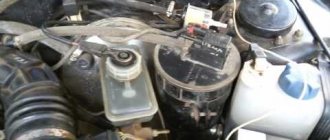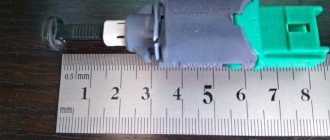A car battery case that functions as a thermal case will help protect not only from dirt and precipitation. But also from the influence of temperature conditions and resolve the issue in frosty conditions. When the temperature drops to -25 degrees, the problem of starting the engine becomes most pressing.
Some buy this device from dealers, while others make it themselves.
Thermal case concept
Until recently, no one could even think that it was possible to have a personal “coat” for a battery. Moreover, it was difficult to obtain suitable materials for the case.
However, scientific and technological progress is rapidly moving forward. And the emergence of new heat-resistant and comfortable bases for such a design has led to widespread adoption of this convenient idea.
The ability of a battery to recharge after standing in frosty conditions overnight is 10%. Therefore, it makes sense to prevent it from completely freezing. Whether your battery will cool down depends on the quality of the thermal case.
Methods for implementing battery heating.
1. Heating with coolant (antifreeze) - circulating in the engine cooling circuit. The stove in the car interior is made using this principle. It is from its pipes inside the engine compartment that you can make a branch and run a tube with cooling liquid around the battery. As the engine warms up, the coolant will also heat up and warm the battery.
The main thing here is not to overdo it; strong heating can lead to the destruction of the elements inside the battery - it can simply boil.
In order to avoid overheating, it is best to place the heating between two sheets of heat-insulating material. Thus, the heating will not overheat the battery, and the heat from the heating itself will be retained by the external contour of the thermal insulation.
2. Heating using powerful resistances from the on-board electrical network.
In parallel, you can connect several chains of series-connected resistors. Their rating is selected according to current and heating temperature. The more parallel circuits there are, the more heat will be generated and the more heating will be consumed.
Do you need a battery case in your car?
This device is optional, that is, it is not included in the required set of devices for the car. Each driver makes the decision to purchase it independently.
A number of different factors will influence this. Much depends on what climate zone you live in and under what conditions you operate your car.
Thermal case can protect the battery from dust, dirt and chemical effects of liquids on difficult routes. It will also prevent mechanical damage, but it will not protect the wires and heating elements.
What happens to Li-ion batteries in the cold?
Due to a decrease in the temperature of the electrolyte, the speed of movement of ions and the intensity of chemical reactions decreases. In practice, it looks like this: at room temperature the battery has a charge of 100%, and after being exposed to the street and further exposure to the cold it drops to 80% or lower, not counting the energy spent on powering the device. But the loss of capacity of lithium-ion batteries in the cold is a temporary phenomenon. Upon subsequent warming up to room temperature, the characteristics of energy storage devices are completely restored.
Irreversible damage only occurs when cooling is below the permissible level of -40 °C. To avoid negative consequences, for most lithium-ion batteries it is recommended not to exceed the lower temperature limit of -20 °C, for lithium iron phosphate batteries - minus 30 °C. In general, lithium batteries and frost are quite compatible. The main thing is to remember that batteries discharge faster in the cold, and long-term storage with a deep discharge leads to inevitable death of the battery.
Battery protection from frost
In winter, the battery can hardly provide high current to the starter. Even if you use high-quality oil, it is not so easy to start the engine in severe frost.
Constantly removing the battery and carrying it home is not an option. This is not convenient and the car remains without an alarm system, which also gets on your nerves.
Experienced car enthusiasts recommend using an insulated battery case in such cases. Especially if you live in cold regions.
Does it always make sense to insulate a battery in winter?
Insulating the battery makes sense if the car is used in regions with cold winters. If the car is driven every day in an area with a temperate climate, and the air temperature does not drop below -15 ° C, then only protection against the entry of cold air through the radiator grille may be sufficient.
If a car sits in the cold for a long time in winter, then no matter how insulated the power source is, it will still cool down. The only way for the electrolyte to heat up is from an external source (motor or heating elements of the thermal cover). When the vehicle is idle, these heat sources do not provide heating to the battery walls.











